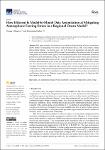Comparing Deep-Sea Larval Dispersal Models: A Cautionary Tale for Ecology and Conservation
Date
2020-06-12Author
Subject
Metadata
Show full item recordAbstract
Larval dispersal data are increasingly sought after in ecology and marine conservation, the latter often requiring information under time limited circumstances. Basic estimates of dispersal [based on average current speeds and planktonic larval duration (PLD)] are often used in these situations, usually acknowledging their oversimplified nature, but rarely with an understanding of how oversimplified those assumptions are. Larval dispersal models (LDMs) are becoming more accessible and may produce “better” dispersal predictions than estimates, but the uncertainty introduced by choosing one underlying hydrodynamic model over another is rarely discussed. This case study uses theoretical and simplified deep-sea LDMs to compare the passive predictions of dispersal as driven by two different hydrodynamic models (HYCOM and POLCOMS) and a range of informed basic estimates (based on average current speeds of 0.05, 0.1, and 0.2 m/s). The aim is to provide generalizable insight into the predictive variability introduced by (a) choosing a model over an estimate, and (b) one hydrodynamic over another. LDMs were found to be up to an order of magnitude more conservative in dispersal distance predictions than even the slowest tested estimate (0.05 m/s). The difference increased with PLD which may result in a bigger disparity for deep-sea species predictions. Although the LDMs were more spatially targeted than the estimates, the two LDM predictions were also significantly different from each other. This means that choosing one hydrodynamic model over another could result in contrasting ecological interpretations or advice for marine conservation. These results show a greater potential for hydrodynamic model variability than previously appreciated by larval dispersal ecologists and strongly advocates groundtruthing predictions before use in management. Advice is offered for improved model selection and interpretation of predictions.
Collections
Publisher
Journal
Volume
Pagination
Number
Recommended, similar items
The following license files are associated with this item:
Related items
Showing items related by title, author, creator and subject.
-
How Efficient Is Model-to-Model Data Assimilation at Mitigating Atmospheric Forcing Errors in a Regional Ocean Model?
Shapiro, Georgy; Salim, M (MDPI AG, 2023-04-27)This paper examines the efficiency of a recently developed Nesting with Data Assimilation (NDA) method at mitigating errors in heat and momentum fluxes at the ocean surface coming from external forcing. The analysis uses ...



